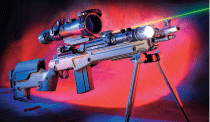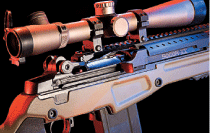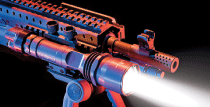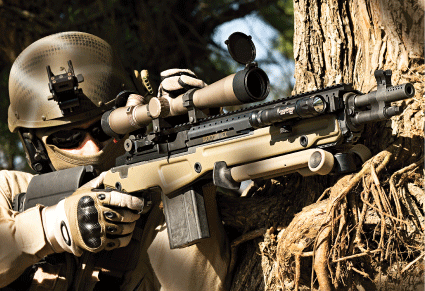Springfield Armory has dabbled in all sorts of projects, such as importing licensed copies of HK G3s made in Greece and FN-FALs from Brazil, but the M1A has and is a solid mainstay. Springfield always manufactured their own receivers, from investment castings that are CNC machined to precise tolerances.
The legacy of the M1A was quickly established as the gun to beat in NRA service rifle competition with National Match and Super Match versions, essentially custom-built target rifles, setting record after record.
Advertisement — Continue Reading Below
The walnut stock, iron-sighted M1A presented such a distinctive profile that Springfield Armory’s logo of a kneeling serviceman  shooting the rifle became their signature brand, even as the company’s 1911 business grew far faster than its M1A sales. In fact, Springfield’s greatest claim to fame remains its incredible brand building in the 1911 market, literally stealing the thunder right out from under Colt’s tent, and growing the 1911 into the iconic handgun that it is today.
shooting the rifle became their signature brand, even as the company’s 1911 business grew far faster than its M1A sales. In fact, Springfield’s greatest claim to fame remains its incredible brand building in the 1911 market, literally stealing the thunder right out from under Colt’s tent, and growing the 1911 into the iconic handgun that it is today.
Their M1A has soldiered on as a steady, if unglamorous, workhorse in the Springfield stable. Historically, the company sold a steady 5,000 to 6,000 M1A rifles a year (source: ATF Rifle Production figures) but getting a steady supply of receivers resulted in a back-order problem. “We’d sell a lot more if we had them,” Springfield co-chairman Tom Reese told me on a visit to the factory several years ago. “We won’t compromise quality, so we build as many as we can.”
Production increased steadily as the company grew, virtually doubling to some 9,000 rifles a year, but then in 2004 everything came together with the introduction of the SOCOM 16 version of the M1A, along with an expanded manufacturing capability.
Advertisement — Continue Reading Below
The SOCOM 16 featured a cut-down 16-inch barrel from the standard 22 inches and was equipped with several sections of the Mil-Std-1913 Picatinny rail on the top of the handguard and along the black synthetic stock, allowing the mounting of a forward eye-relief optic on the top rail and a choice of accessories, such as a bipod or SureFire WeaponLight on the stock.
The SOCOM 16 featured a new muzzle brake with a series of small ports instead of the large birdcage configuration of the original M14. Shooters were amazed at how controllable the short-barreled SOCOM 16 proved to be with the new brake. Whether or not it was designed to defeat “flash hider” laws is immaterial, as it was hailed as a highly effective brake by shooters.
 The SOCOM 16 was indeed handy, light and fast with an Aimpoint or other close-combat optic (CCO) on its forward-mounted top rail, but one couldn’t mount a conventional magnifying riflescope. Springfield addressed this issue with an updated version called the SOCOM II introduced in 2005.
The SOCOM 16 was indeed handy, light and fast with an Aimpoint or other close-combat optic (CCO) on its forward-mounted top rail, but one couldn’t mount a conventional magnifying riflescope. Springfield addressed this issue with an updated version called the SOCOM II introduced in 2005.
Advertisement — Continue Reading Below
Gun Details
The key difference between the SOCOM 16 and the SOCOM II was a different handguard system, essentially a solid aluminum unit that included a full-length Mil-Std-1913 Picatinny rail on the upper portion and three shorter sections of rail at 3, 6 and 9 o’clock. Fully CNC from aerospace-grade aluminum and Mil-Spec hard anodized, the new handguard was dubbed the Cluster Rail System (CRS) by Springfield Armory.
Springfield’s CRS is designed and manufactured by Vltor of Arizona, the innovative tactical accessory company that manufactures what many consider to be the best aftermarket stock out there for the AR-15, the EMOD stock, as well as AR rail forends, receivers and complete uppers. Originally, the CRS was developed as the CAS-14 to be sold as an aftermarket accessory, but Springfield saw the potential that a complete Picatinny forend would afford the SOCOM II.
The SOCOM II’s CRS handguard can be ordered in an “extended” configuration with a longer upper rail section that connects to the stripper clip guide and makes the SOCOM II scope-worthy for conventional magnified optics and not just extended eye-relief CCOs like L-3 EOTech and Aimpoint.
Advertisement — Continue Reading Below
 With the extended CRS rail, a Trijicon ACOG or a tactical scope like Leupold’s Mark IV can be mounted precisely in line with the barrel, something that’s a bit of a hit-and-miss affair with the sidesaddle scope mounts that otherwise must be used. For long range precision shooting, the sidesaddle mounts are not as well aligned as the CRS and not as stable.
With the extended CRS rail, a Trijicon ACOG or a tactical scope like Leupold’s Mark IV can be mounted precisely in line with the barrel, something that’s a bit of a hit-and-miss affair with the sidesaddle scope mounts that otherwise must be used. For long range precision shooting, the sidesaddle mounts are not as well aligned as the CRS and not as stable.
However, one problem remains with the SOCOM II for optimal performance with a magnified riflescope, the stock. Of conventional shape, the black fiberglass stock of the SOCOM II does not permit a head position with a proper cheek weld for a scope. It’s made for iron sights and even with a forward-mounted red dot CCO, you have to lift your head off the stock to get a sight picture.
A great way to solve the stock problem is to order a JAE-100 stock from J. Allen Enterprises. This radical stock design includes the necessary adjustable comb to allow for correct head positioning and a solid cheek weld, but it doesn’t stop there. Machined from solid aluminum and then chemically bonded with a plastic-like outer covering, the JAE-100 stock actually increases a SOCOM II’s accuracy substantially.
Advertisement — Continue Reading Below
How? The stock, with its precision CNC machined aluminum bedding blocks, basically becomes a giant pillar bedded interface for the barreled action. Precision riflesmiths like Kenny Jarrett have long advocated the pillar bedding method to squeeze the best accuracy from bolt-action rifles, and that’s exactly what the JAE stock does without any gunsmithing.
It takes all of ten minutes to remove a SOCOM II from its factory stock and secure it into the JAE stock.
The JAE-100 stock features Picatinny rail sections at the forend at 9, 3 and 6 o’clock as well as a small section at the toe of the stock to install an optional monopod for precise elevation adjustments from a secure hide. There are palm rest inserts and pistol grip inserts available from J. Allen Enterprises as well, making the JAE stock a versatile modular upgrade for the SOCOM II. At $599 retail, the JAE-100 may be the best bargain in the accessory world for an M1A.
 Shooting Impressions
Shooting Impressions
With the JAE-100 stock in place, groups shrank from 1.5 inches at 100 yards to 0.75 of an inch, less than 1-MOA. While the increased accuracy from the JAE stock is indeed worth it, the reduced ballistic performance of the SOCOM II’s abbreviated barrel warrants mentioning. Six inches of lost barrel reduces the muzzle velocity between 200 and 300 feet per second (fps) with military issue M80 ball. That’s not a big deal with the M80’s 150-grain projectile, as it will still carry enough retained velocity at 300 yards to be effective, but I’d be concerned with such a velocity loss using 168- or 175-grain match loads. Then again, if I wanted to shoot match loads in an M1A, I’d get a standard version with a 22-inch barrel and leave the SOCOM II for what it does best—fast and close shooting.
Advertisement — Continue Reading Below
Springfield Armory has come a long way. Guns like the SOCOM II are one very good reason behind the success.
Check out Springfield’s Loaded M1A LE Rifle.
Advertisement — Continue Reading Below























